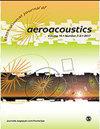Systematic validation of the PAAShA shielding prediction method
IF 1.3
4区 工程技术
Q3 ACOUSTICS
引用次数: 0
Abstract
Based on classical diffraction theories with modifications and extensions in analytical formulations and numerical implementations, a new code has been developed at NASA for the prediction of aircraft noise shielding, named as Propulsion Airframe Aeroacoustic Shielding Attenuation (PAAShA). The code is developed primarily for aircraft system noise predictions, although it may also be useable in other applications with acoustic shielding. The requirements for this code are driven by the need for a robust, capable code to use with NASA’s Aircraft Noise Prediction Program (ANOPP) for aircraft integration and system noise research. The requirements are met and include capabilities to use a wide range of aircraft geometries, rapid calculation times consistent with aircraft system noise problems, and the flexibility to model realistic noise source characteristics and distributions. The accuracy and robustness of the method are demonstrated in this paper with a set of problems, including a cylinder, a finite plate, a symmetrical two-dimensional airfoil, and a full three-dimensional hybrid wing body aircraft model tested in a wind tunnel. This range of problems demonstrates both smooth and sharp edge diffraction capabilities for a wide range of frequencies and low Mach number flow effects at low angles of attack. Predictions are shown to be accurate to within 1–4 dB over a wide range of the most significant frequencies and directivity angles. This is determined by comparing with data, which have experimental uncertainties, particularly at high frequencies, high angles, and source characteristics. The accuracy diminishes for geometries that include a significant reflection component, which is not calculated by the code. Accuracy can also be somewhat diminished for high azimuthal angles. Accurate modeling of the noise source, particularly its frequency and directivity characteristics, is essential to obtaining accurate results.PAAShA屏蔽预测方法的系统验证
基于经典衍射理论,在分析公式和数值实现中进行了修改和扩展,美国国家航空航天局开发了一种用于预测飞机噪声屏蔽的新代码,称为推进机身空气声屏蔽衰减(PAAShA)。该代码主要用于飞机系统噪声预测,尽管它也可用于其他具有声屏蔽的应用。该代码的要求是由于需要一个稳健、有能力的代码,以便与美国航空航天局的飞机噪声预测计划(ANOPP)一起用于飞机集成和系统噪声研究。满足了这些要求,包括使用各种飞机几何形状的能力、与飞机系统噪声问题一致的快速计算时间,以及建模真实噪声源特性和分布的灵活性。本文通过一组问题证明了该方法的准确性和稳健性,这些问题包括圆柱体、有限板、对称二维翼型和在风洞中测试的全三维混合翼身飞行器模型。这一系列问题证明了在宽频率范围内的平滑和尖锐边缘衍射能力,以及在低攻角下的低马赫数流动效应。预测结果显示,在最显著的频率和方向角的宽范围内,准确度在1–4 dB以内。这是通过与具有实验不确定性的数据进行比较来确定的,特别是在高频、高角度和源特性下。对于包含重要反射分量的几何体,精度会降低,而这些分量不是由代码计算的。对于高方位角,精度也会有所降低。噪声源的精确建模,特别是其频率和方向性特性,对于获得准确的结果至关重要。
本文章由计算机程序翻译,如有差异,请以英文原文为准。
求助全文
约1分钟内获得全文
求助全文
来源期刊

International Journal of Aeroacoustics
ACOUSTICS-ENGINEERING, AEROSPACE
CiteScore
2.10
自引率
10.00%
发文量
38
审稿时长
>12 weeks
期刊介绍:
International Journal of Aeroacoustics is a peer-reviewed journal publishing developments in all areas of fundamental and applied aeroacoustics. Fundamental topics include advances in understanding aeroacoustics phenomena; applied topics include all aspects of civil and military aircraft, automobile and high speed train aeroacoustics, and the impact of acoustics on structures. As well as original contributions, state of the art reviews and surveys will be published.
Subtopics include, among others, jet mixing noise; screech tones; broadband shock associated noise and methods for suppression; the near-ground acoustic environment of Short Take-Off and Vertical Landing (STOVL) aircraft; weapons bay aeroacoustics, cavity acoustics, closed-loop feedback control of aeroacoustic phenomena; computational aeroacoustics including high fidelity numerical simulations, and analytical acoustics.
 求助内容:
求助内容: 应助结果提醒方式:
应助结果提醒方式:


